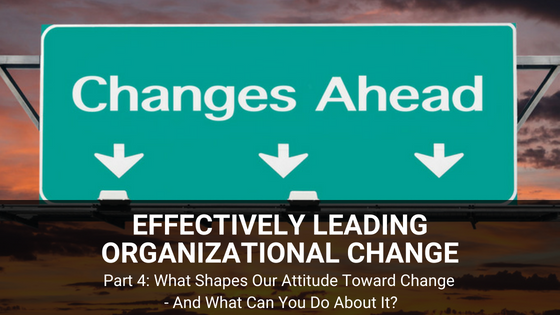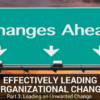Communication, Executive Coaching, Leading Change
Effectively Leading Organizational Change, Part 4
What Shapes Our Attitude Toward Change – And What Can You Do About It?
We are currently working with several organizations in the midst of implementing major changes. In each situation, the organizations have good reasons to justify the changes and they have well-thought-out lists of actions to implement the changes. We have worked with these organizations to implement the practices outlined in our previous blogs on Effectively Leading Change; yet some employees continue to struggle to implement while others forge ahead enthusiastically. So what makes the difference in their attitudes?
The following are some of the factors that influence a person’s response to change:
- Family upbringing
Our attitudes about change are partly determined by the way our families reacted to change during our early years. People who live in the same house, attend the same church, shop at the same stores, and drive the same routes daily throughout their formative years may have more difficulty dealing with change than people who grow up in several different neighborhoods. In the same vein, those who become accustomed to associating with people with the same values and ethics may find it more difficult to appreciate the diversity of today’s workforce. - Past successes and failures
To a great extent, the ways in which we have experienced changes in the past determines how we view the change process in the future. If our past experiences during times of change have been mostly positive, we will have a more optimistic outlook about the change process. But, if we have experienced failure during periods of change, those failures may color our outlook about future changes. - Mental outlook
People with high self-esteem and self-confidence are better equipped to deal with changes in both their personal and organizational life. They have confidence, not only in themselves, but in the leadership above them. Self-confident people have an understanding of their part in the change process and see the value of dealing with change positively. This positive mental outlook enables them to consider the possibility that the change process might even provide greater opportunities for them and enhance their personal and career growth. Insecure people, on the other hand, just see the change process as threatening. - Communication
The way in which the change process is communicated to people within the organization is a critical factor in determining their reactions. When upper management plans and communicates effectively with all employees and explains the reasoning behind the change, employees are much more likely to buy into it. Changes that are mandated with little communication, on the other hand, are often poorly received, since employees may feel that the change is being “shoved down their throats.” - Ability to control the situation
People are more likely to understand and implement changes when they feel they have some control. Keeping the doors of communication open and soliciting input from employees lets them know that their contributions matter. This, in turn, helps give them a sense of control during periods of change. - Job satisfaction
The satisfaction that employees have with their job determines a portion of their reactions during times of change. Employees who experience a high degree of job satisfaction are better able to weather periods of change. They are more positive in their approach to their work and can see change as an organizational necessity. Unhappy employees, on the other hand, view change as just another annoyance in a long list of complaints - Level of trust
In organizations where there is a high degree of trust and each individual employee is treated with respect and dignity, there is less resistance to change. In organizational environments where there is a high degree of distrust, change is viewed as just one more of management’s tricks. In such organizations, change will be resisted, not because employees find it unwarranted, but simply because they mistrust everything management does. In these cases, employees see the necessity of change but they don’t trust the change agents. - Age and values
Reactions to change are also partly determined by age and values. Generally, but not always, people tend to become more resistant to change as they age. The older they get, the more comfortable they are when operating within known parameters and predictable routines. Values also play a big role. People who place a high value on stability, the status quo and control over their environment may be more resistant to change than those who value risk-taking and exploration, and get excited about the unknown. - Timing
Timing also has a significant impact. If a change occurs at a time when an employee is feeling financially secure, he or she may view the change positively. However, if the same change occurs during a time of financial insecurity, the employee may see it negatively. How fast an employee receives word of the change also affects the response. If a change has been thoroughly communicated within the organization over a long period, the employee may more readily accept the change. However, an employee who is suddenly confronted with change may be resistant and even try to sabotage the change process.
Now that you know what makes the difference in people’s attitudes about change, here is what you can do to help them choose a positive attitude and approach to your next change initiative:
Get to know your people individually. As a result of all the factors mentioned above, individuals are at different levels of readiness for change. Meet with individuals discuss where they are in the change process. Which of the aforementioned factors most affect their view of the change? Ask about their past experience with change and get to know their concerns, needs and ideas; then create a plan to help move each person toward the goal.
Discuss resources and training. People often think about what they will have to give up. Create a perspective of abundance and help people focus on what they will gain. Ask about the resources and training they believe they need to be successful and then develop a plan to provide the needed equipment, materials and training.
People can only handle so much change at one time. Too often, organizations attempt to change too many things at one time. Set priorities and focus on the most important changes first. Keep a long-term view of changes needed for the future and focus on not more than two changes at a time.
By implementing these strategies to help individuals choose a new attitude and succeed during times of rapid change, you will increase the likelihood of both individual and organizational success. For more information and practical ideas on leading change, be sure to refer back to other blogs in our Four-Part Series on Effectively Leading Change to guide your team through a new way of doing things to a new future.











One Comment
Su
I agreed with this point: “People can only handle so much change at one time.” Too many changes will also lead to the confusion on the priority. We want to make a change for improvement, but situation can worsen if change not being manage or communicate well